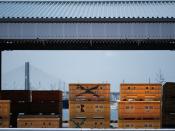Needs to be updated; current situation as changed Quality is good, but more quantity is necessary
It is unfortunate that the U.S. chose to use automobiles as its wedge to open the alleged 'closed' markets of Japan. One Japan-based managing executive of the Big Three has even admitted that they consider the Japanese automobile market to be open. Japan is not the island of protectionism in a sea of free trade that its critic allege. The problem for the U.S. auto-makers is not a lack of market access, but a lack of effort. The first step required for the U.S. auto makers to sell competitively in Japan is not to impose of ridiculous tariffs, but to have Detroit bring up the quality to Japanese standards. All in all, the U.S.'s decision to use automobiles as its wedge to open the Japanese market was surely a dangerous one. In addition, the utilization of unilateral actions by the U.S.
is clearly a violation of international trade law. Not only is this decision a resemblance of managed trade but a policy which will weaken the leadership position of the U.S. in the world economy as well.
The U.S. needs to do what the Japanese did when they penetrated the American market; hard market research and heavy investment. The Japanese spent billions of dollars studying American taste and manufacturing models that suited them. The Big Three have generally confined their efforts to sending models that they have made specifically for Americans. Bill Duncan, the head of the Japan Automobile Manufacturers Assn. states that 'it was the basic principals of competition that made the Japanese automobile industry strong.'
One example which reflects the short-sightedness of the Big Three is the insufficient number of right-hand models available in Japan. Since cars in Japan are driven on...



Good
Nice essay
with good use of facts
1 out of 1 people found this comment useful.